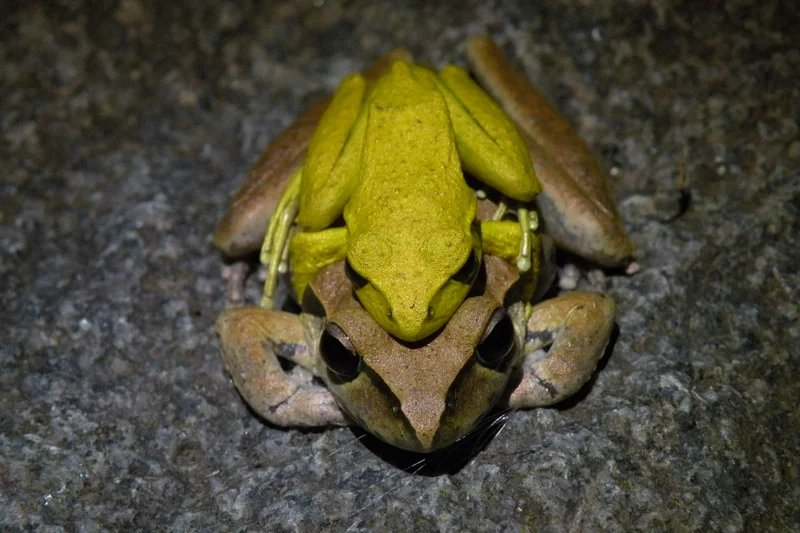Frogs in love: A rainforest romance
Learn more about Eastern Stony Creek Frogs and how you can help them here on our Sunshine Coast.

Can you guess why the yellow frog is piggy - or rather froggy - backing on the other?
That’s because the two frogs are in a mating position called amplexus. This is a behaviour that is common in many frog species, where the male (smaller frog) hops on the female’s back and grasps her in a tight embrace to fertilise the eggs externally, as the female lays them. Did you know that amplexus can last from about five seconds to several months depending on the species?
Sizing them up
In Eastern Stony Creek frogs, males are considerably smaller than females, with a body length of four to five centimetres, whereas females measure about seven centimetres. During the breeding season (spring and summer), adult males will change colour on parts, or the whole of their body, going from brown to light greenish or lemon-yellow, while females maintain a brown colouration all-year-round.
Wait, how many eggs?!
Female Eastern Stony Creek Frogs lay from several hundred to 1,000 eggs in a single cluster, in streams or creeks. You may be wondering how the eggs don’t simply run off with the water? When the female lays her eggs, they attach onto rocks or gravel in the water. Tadpoles will hatch about a week later and will latch onto rocks using their mouthparts to avoid being washed away by water. Once they have hatched, it will take tadpoles about two months to fully develop into frogs.
Where do they live?
Eastern Stony Creek Frogs generally live in rainforests, woodlands or sclerophyll forests, typically near rocky streams but can also inhabit suitable dams. Their diet consists of insects and other invertebrates.
On the Sunshine Coast, Eastern Stony Creek Frogs tend to be found in the hinterland. Some of the Council reserves where the species has been observed include Kirbys Road Environment Reserve, London Creek Environment Reserve, Annie Hehir Road Environment Reserve and Tuan Environment Reserve.
If you are ho(p)ping to see these critters, it is best to visit these reserves when it is dark, as Eastern Stony Creek Frogs are nocturnal, meaning that they are active at night.
Frogs are very important when it comes to maintaining healthy ecosystems. However, many frog species in Australia are declining at a fast rate due to habitat loss, climate change and pollution.
How can you help our native frogs?
- Download the Frog ID App and record frog calls to inform frog conservation.
- Please keep your cats in at night. Like the Eastern Stony Creek Frog, many of our native frogs are most active at night.
- If you have a backyard, you can plant native vegetation and build a DYI frog pond! This will create habitat for native frogs and will attract these critters to your garden.
- How can you keep invasive Cane Toads out? One of the best ways to prevent Cane Toads from accessing and enjoying your frog pond is to raise it above-ground as Cane Toads are very poor climbers or jumpers.
- Avoid using pesticides and herbicide near water sources or other area where frogs may live, as these chemicals are toxic to frogs and can impact their health and development.